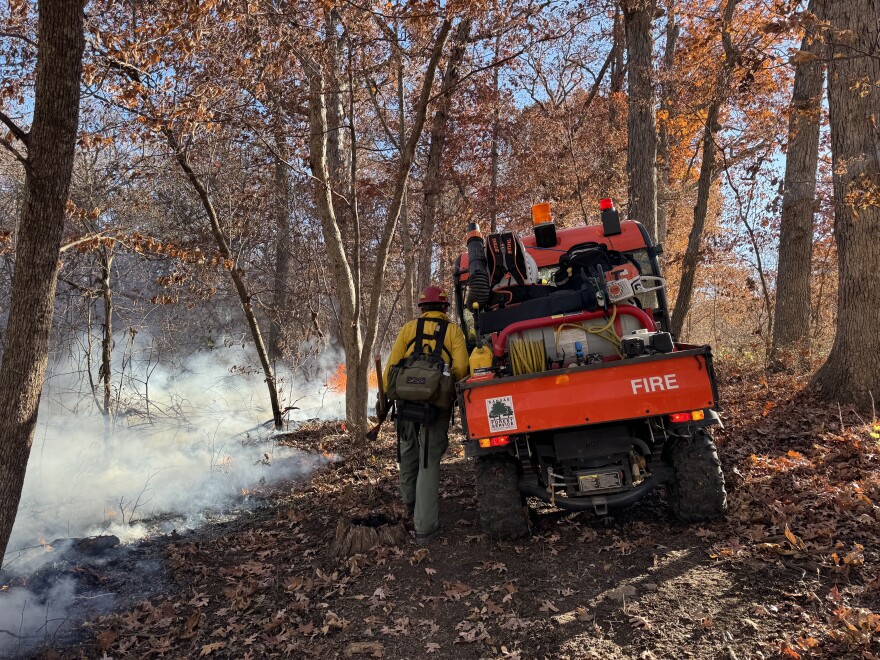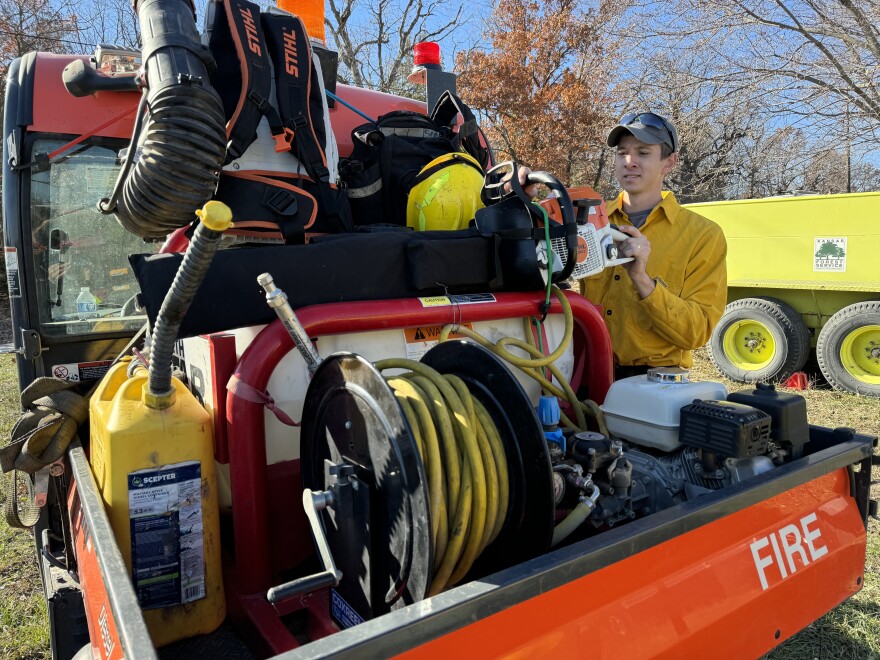Most of the Kansas Forest Service’s budget for this fiscal year might simply not show up.
That’s the fear — with just 2.5 months left in the federal fiscal year — as the Trump administration continues to withhold federal money that states and tribal governments use for forestry and for preventing and combatting wildfires.
“One of the main things we do with this funding is provide training, response resources, response assistance” for wildfires, State Forester Jason Hartman said.
Politico reports that President Trump's budget director has repeatedly told Congress that Trump can use “pocket rescissions” to cut congressionally approved spending by pushing the matter back so late in the fiscal year that the funding expires and Congress can’t do anything about it.
The Government Accountability Office considers the move unlawful and some Republican leaders agree.
Losing this year’s funding will hit rural areas the hardest
In recent years, federal funding typically makes up 60% to 80% of the Kansas Forest Service’s budget. This money arrives from the U.S. Forest Service.
The federal agency sent the Kansas Forest Service about $2.4 million last year. Kansas expected to receive a similar slice this year of the hundreds of millions of dollars approved by Congress for state and tribal forestry and firefighting.
The U.S. Forest Service didn’t respond to a media inquiry about the status of this year’s funding.
However, a senator from Washington state publicly pressed the federal agency’s chief in a hearing last week, asking why the money hadn’t been released.
“We are evaluating that right now,” U.S. Forest Service Chief Tom Schultz replied, adding that his agency is communicating with White House budget staff. “We have not made a determination yet.”

Losing this year’s money would hurt rural fire departments. The federal dollars go in part to them, in the form of grants that pay for protective gear and other firefighting equipment.
Rural departments are the vital, frontline responders when it comes to the kind of fires that the Kansas Forest Service focuses on preventing and combatting — wildfires that sweep across the state’s prairies and woodlands.
This means the state forestry agency directs much of its support specifically to rural firefighters, and that losing federal funding will hit rural departments harder than their urban counterparts.
“Our mandate, our mission has always been the smaller, rural departments,” Hartman said.
Kansas sees about 4,000 wildfires each year.
Wildfires on the Great Plains are becoming more severe. This is partly because of human changes to the landscape and the atmosphere that are causing juniper trees and other woody plants to take over what was once a prairie region.
The amount of land that burns each year in major wildfires on the Great Plains increased fivefold in the last 30 years, University of Nebraska researchers found.
Scientists also say that climate change is upping the risk of wildfires year-round in Kansas, and firefighters have noticed for years now that even winter has become a risky time of year.
Normally this year’s federal funding would have arrived by now
Typically, the Kansas Forest Service gets its funding from the U.S. Forest Service in May or June. This year, the state agency not only hasn’t received the money — it hasn’t received information that should have arrived last winter, confirming how much funding to expect.
That’s despite the fact that the federal fiscal year is already more than nine months over.
“ We kept hearing a lot of: ‘We’re not sure. Things are unknown. Wait. We’ll let you know as soon as we hear something,’” Hartman said.
Now officials at the agency are receiving signals that the money won’t come at all — or else that the federal government will act so late in the fiscal year that the state agency would struggle to complete the necessary paperwork.
That’s because, after receiving funding notification, the state agency will still have to assign all the money to various projects, show the U.S. Forest Service that all the spending will meet laws and regulations, and then get the final federal signoff. Without this part of the process, the funding falls through.
“The end of June is when we heard that actually (the current fiscal year’s funding) is probably not coming at all,” Hartman said.

The Kansas Forest Service issued an urgent public message encouraging people to contact Congress.
“We don’t know exactly why (the president’s budget office) is withholding funding appropriated by Congress,” the message said, “but we can guess this is a larger effort of the Administration to use untested executive authority to ‘cut’ spending.”
The money lets Kansas train more than 1,500 firefighters per year across the state. It also helps get trucks, generators and hand-tools for rural fire departments.
Right now, the state agency is still making ends meet with federal money that it received during the Biden administration.
But leaders are bracing for the impact of losing the dollars they expected to receive by this summer to keep their work going.
“The effects are immediate,” Hartman said. “We have to start preparing.”
Adding to the stakes, agency officials already knew that the Trump administration wanted to eliminate most of the funding that would flow to the agency in the next fiscal year.
The Kansas Forest Service has stopped filling openings when people leave. It has two unfilled jobs right now that help cities and private landowners maintain healthy woodlands and street tree canopies.
That’s just the start.
More jobs are slated to go vacant after upcoming retirements. And if federal funding doesn’t resume, the situation will push the agency into layoffs.
“Within two years, there would be pretty drastic effects on the staffing and services we provide,” Hartman said.
The agency says it won’t have the resources for its work tracking invasive species that destroy trees and helping communities address them.
Many communities will lose help inventorying and maintaining their tree canopies.
Farmers, ranchers and other owners of large properties will lose the technical help that the agency currently offers for keeping woodlands healthy and planting tall, thick hedgerows that help combat topsoil loss, provide wildlife habitat and shield crops from wind.
Celia Llopis-Jepsen is the environment reporter for the Kansas News Service and host of the environmental podcast Up From Dust. You can follow her on Bluesky or email her at celia (at) kcur (dot) org.
The Kansas News Service is a collaboration of KCUR, Kansas Public Radio, KMUW and High Plains Public Radio focused on health, the social determinants of health and their connection to public policy.
Kansas News Service stories and photos may be republished by news media at no cost with proper attribution and a link to ksnewsservice.org.


